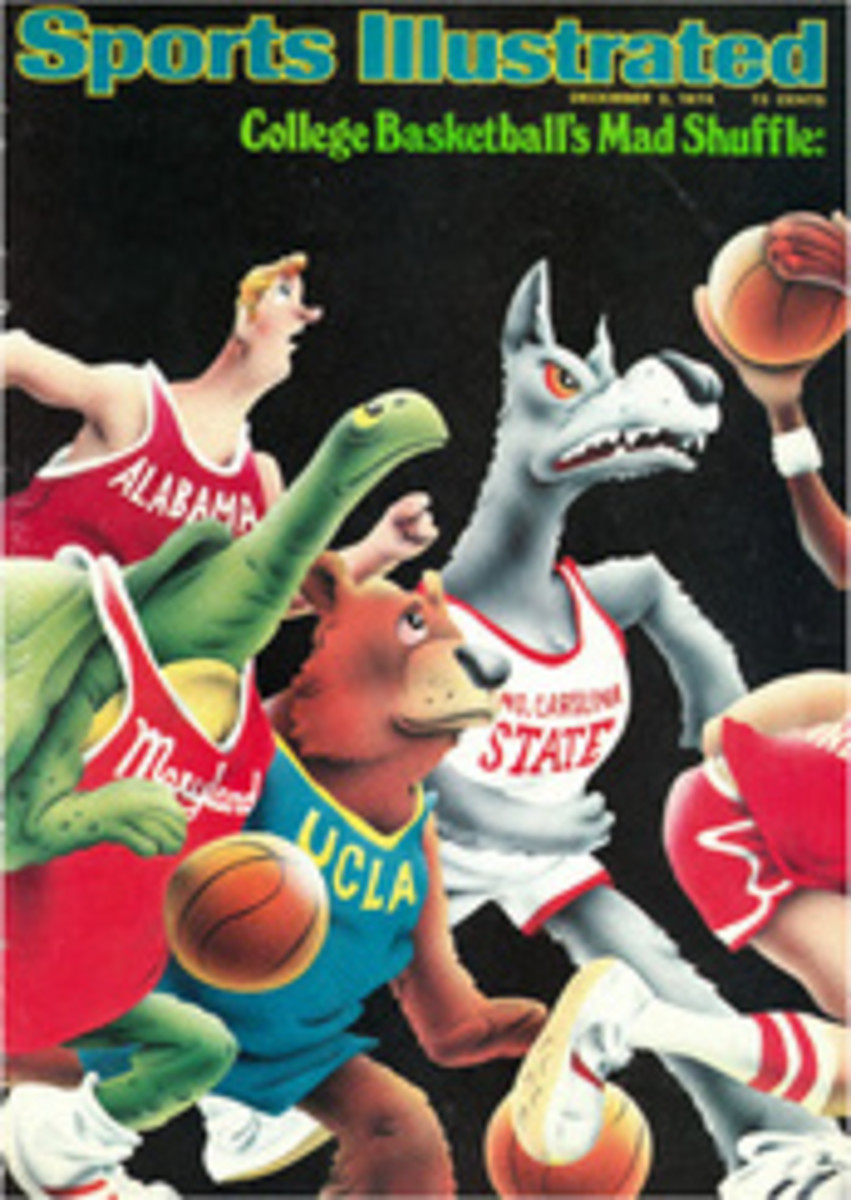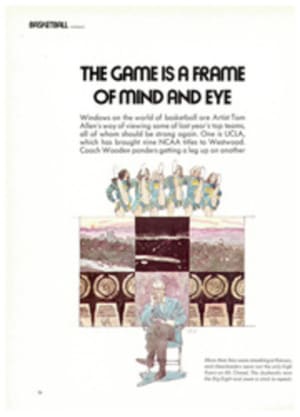
SCORECARD
SAYONARA NAGASHIMA-SAN
He stood there before his last game on his home ground in Tokyo's Korakuen Stadium, trying to speak. Instead, he burst into tears. There were many in the crowd of 50,000 who cried too, a phenomenon almost unknown in a land where, traditionally, emotion is frowned upon.
Gracefully, as one Japanese sports daily put it, he agreed to accompany the N.Y. Mets tour as a player for the Japanese side. The thunderous applause the Mets heard wherever they went was as much a sayonara (goodby) to him as a polite konnichi wa (good day) for the Mets.
The recipient of all this adulation was not Sadaharu Oh, the home run hitter whose name is becoming almost as well known on this side of the Pacific as in Japan, but Shigeo Nagashima. In 17 years with the Tokyo Giants, Nagashima came to be regarded as a Ruth, Gehrig and Cobb wrapped in one. Better, one Japanese wrote, he was "a samurai in the ball game."
There was nothing mystical about Nagashima's play. Like Brooks Robinson, he caught almost everything hit near him at third and had a lightning toss to Oh at first. At 5'10" and 171 pounds an exact physical duplicate of Oh, he finished out his career with a .305 lifetime average and 444 home runs. He was the Central League's most valuable player five times, its leading batter six and its home run king twice. But it was his knack of hitting with men on base in the late innings that was most impressive. Time and again, for example, it was Nagashima's key hit that embarrassed the Mets and drove the crowds wild. Japanese teams had their best showing ever against visiting Americans, winning seven of 18, tying two.
At 38, Nagashima will now manage the Giants, a fact that Japanese find symbolic. Loyal samurai never change their allegiance. If his club should ever have a bad season—unthinkable in recent history—Nagashima will probably follow his accustomed course after an off year. He will disappear into the hills at the foot of Mount Fuji and rejuvenate body and spirit by running mile upon mile, day after cold day. Of such are Japanese legends made.
OVEREXPOSURE
The situation called for immediate, if not radical, measures. Not only did nobody come out to watch Greenwich (Conn.) High's cross-country team—one of the five best in the state these past few years—the runners were not even invited to the school's annual fall sports rally. Three of them decided they would show GHS a thing or two. They ran without their pants. Got good publicity, too. They were suspended for the next meet.
HEAR! HEAR!
For more than two years England's Football Association has been hacking away at a jungle of rules and procedures hoping to find a path into open soccer. It has succeeded so far only in miring the Rothmans Ismian League in quicksand.
Eager to dump the burden of shamateurism and hypocrisy, 16 of the 40 RIL amateur clubs, anticipating that the association would soon pass an open soccer rule, went professional—and just about broke. The other teams remained amateur, and profited by attracting the best players, who preferred their old "money-in-the-boot" payments—which go unrecorded and untaxed—to cash on the barrelhead. Some amateurs reportedly make ¬£40 a match.
After the professional Hendon and Walton clubs lost almost all their first-stringers to other teams, RIL Chairman Barry East was furious. "What has happened is immoral," he said. "The honest clubs are paying a frightful penalty." East promised he would be merciless once all the RIL was professional and the players were trying to jump back to their old teams. "These amateur clubs better not turn to me for protection on the movement of players," he said. "They can stew in their own juice." The words must have sent shivers through the shamateurs.
THAT WAS NO BIRD
We have been holding this report on the Evel Knievel syndrome until Walter Cornelius had his try at the River Nene in Peterborough, England, but something tells us old Cornelius never is going to go and maybe that is just as well.
Cornelius' excuse now is that he is too heavy. The 54-year-old swimming pool attendant is trying to lose a stone or two before getting himself into the huge slingshot that will wing him 50 yards to the other side of the Nene. Earlier this year he tried to fly across the river from the roof of a supermarket in a Batman suit with wings, missed and plunged straight into the water. He will have the wings again, he says, "but this time I shall have more propulsion. If I can get 20 men to hold me in the catapult and stretch the elastic, that should be enough to launch me to the far bank. I am convinced my idea will make Knievel's stunt look like a Sunday afternoon outing."
This fall the world was full of people, most of them small boys on bikes, who were determined to equal the great Snake Canyon fizzle. Most succeeded. Our two favorites:
Evel Kohicken (that's his name, rhymes with No Chicken) dressed as a rooster and set out in a pedal-powered "sky cycle" at Spring Hill, Fla. to cross Lake Hunter. About halfway out he suffered a loss of pedal power. Two frogmen had to pluck him from the lake.
Gary Erdelen of Kennewick, Wash, practiced all day for a ramp-to-ramp jump of 60 feet on a motorcycle at the Tri City Speedway in Richland. Next day, disaster. With exquisite timing, the cycle ran out of gas as Erdelen roared up the takeoff ramp. Seems he forgot to fill the cycle's tank after all that practice. The cost of that lapse: two broken legs, broken pelvis, various internal injuries and $5,000 to $7,000 in hospital bills. Erdelen's share of the gate came to $400.
Puts us in mind of the latest Evel Knievel joke (yes, unfortunately, there are those), the Evel Knievel Drink. Pour yourself a glass of champagne, toast yourself, drink, set the glass down—and throw yourself against the fireplace. Well, it's as sensible as all those harebrained stunts, and probably safer.
LONG TIME NO ZEE
That arbiter of barroom arguments, the Guinness Book of World Records, takes a header when it comes to the origin of ice hockey, claims Donald W. Friedman, director of the office of public information at the University of Connecticut. The book puts the first pictorial evidence of the game in Holland "as early as 1600 A.D." Too late, says Friedman, who spotted a Dutch lad slapping a shot past a sprawled goalie in the background of an etching by Frans Huys that is part of the college museum's current exhibition, "Antwerp's Golden Age." The etching's date: between 1558 and 1561.
A SORE TOPIC GETS SORER
It is still illegal to sore the forelegs or feet of the Tennessee Walking Horse by use of irritants—the cruel practice causes the animals to pick up their hoofs in a judge-pleasing, high-stepping gait—but new regulations issued by the Department of Agriculture last year make it "virtually impossible" to prosecute cases involving soring. That is the lamentable conclusion of Thomas F. Turley Jr. of the U.S. Attorney's office in Memphis after all but one of 33 indictments returned by a federal grand jury in July, 1973 against owners, trainers and exhibitors at the Cotton Carnival Horse Show were dismissed this fall.
The regulations stem from tests conducted jointly by a branch of the agency and representatives of the walking horse fraternity. Said the department, "The test found that horses, much like humans, exhibit varying degrees of sensitivity—that devices that might harm one horse would not necessarily harm another." It concluded: "The responsibility for adapting a particular device to an individual horse should rest with the trainer of each horse. Trainers certainly should know when a horse is sore and what made the horse sore."
The logic is impeccable. The man who beats his wife should be the judge of whether she is hurt or not, since some women can absorb more punishment than others, a nicety that only an expert wife-beater can discern.
Fortunately, women can and do speak up for themselves these days. Since horses cannot, a suggestion to Agriculture: write new regulations that put responsibility for policing the systematic torture of the walking horse back where it was previously and where it belongs, on department veterinarians or inspectors, or stand accused as an equal partner in equine crime.
SOUP FOR NUTS
At this season of Thanksgiving it is perhaps fitting to give thanks once more for that mouth-watering book The Baseball Encyclopedia, and its feast of nicknames of major league players. A menu drawn from its pages might well feature the traditional Turkey (Tyson), but it also could include Ham (Hyatt), Goose (Goslin), Chicken (Hawkes), Rabbit (Maranville), Ribs (Raney) and Possum (Whitted). For diners on a budget, there are Stew (Bowers) and Sweetbreads (Bailey). Seafood lovers could choose Shad (Barry), Snapper (Kennedy) or Catfish (Hunter), starting off with an Oyster (Burns) or six. Soup (Campbell) would have its place on any table, and it would be appropriate to wolf down a Cuke (Barrows), Spud (Chandler) or Yam (Yaryan), taking care to save room for Pickles (Dillhoefer), Noodles (Hahn), or even Chile (Gomez).
Sips of a Highball (Wilson) might precede the meal for many, but for beer drinkers there would be both Bock (Baker) and regular Suds (Sutherland), and for teetotalers a variety of Ade (Garrett) and Juice (Latham). A little cream Sherry (Robertson) would go down smoothly, after one indulged in a Cookie (Lavagetto), some Peaches (O'Neill) or Pie (Traynor), got the jaws working on some Taffy (Wright) or other Candy(Cummings) and stirred Sugar (Cain) into a cup of coffee. Anyone nursing another Highball or Bock into the evening would naturally have a few Pretzels (Pezzullo) or Peanuts (Lowrey).
POLLY-PHONY
The problem seemed insoluble. Airline ticket agents at the Hyatt Regency Hotel in Atlanta were being cut off three or four times in the course of a single conversation. Even the birds in the lobby cocktail lounge—two scarlet macaws, one Mexican double-yellow-headed parrot and one Mexican red-headed parrot—seemed irate, screeching their silly heads off. The birds? Come to think of it, the lines went out every time one of them let out a yawp.
Communications Director Bob DeLoach finally figured out that the birds' calls were on the same frequency as a signal that instructed the computing equipment to disconnect the line, register the amount of time it was in use and make a record for billing (no pun there). De-Loach got the better of the fine feathered fiends by installing noise-canceling microphones, but that did not answer the question of why the birds were so querulous. The bartender knew. People in the lounge fed them cherries and fruit from their drinks and—there really is no delicate way to put this—they were constantly smashed.
ILLUSTRATION
THEY SAID IT
•Harold Ballard, owner of the Toronto Maple Leafs, on the timid approach his disappointing team has displayed so far this season: "You could send Inge Hammarstrom into the corner with six eggs in his pocket and he wouldn't break any of them."
•Joyce McGonnigal, of Johns Hopkins, on the type of audience attracted by women's sports: "Usually boyfriends, lovers and other strangers."
•Field Scovell, chairman of the Cotton Bowl selection committee, on Bear Bryant's credibility: "If Bear tells me it's raining, I don't look out to see. I go get an umbrella."
•Steve Carlton, Phillies pitcher, on the trades that sent three of the National League's leading sluggers to the American League: "No more Hank Aaron, Billy Williams or Bobby Bonds. I like that."

